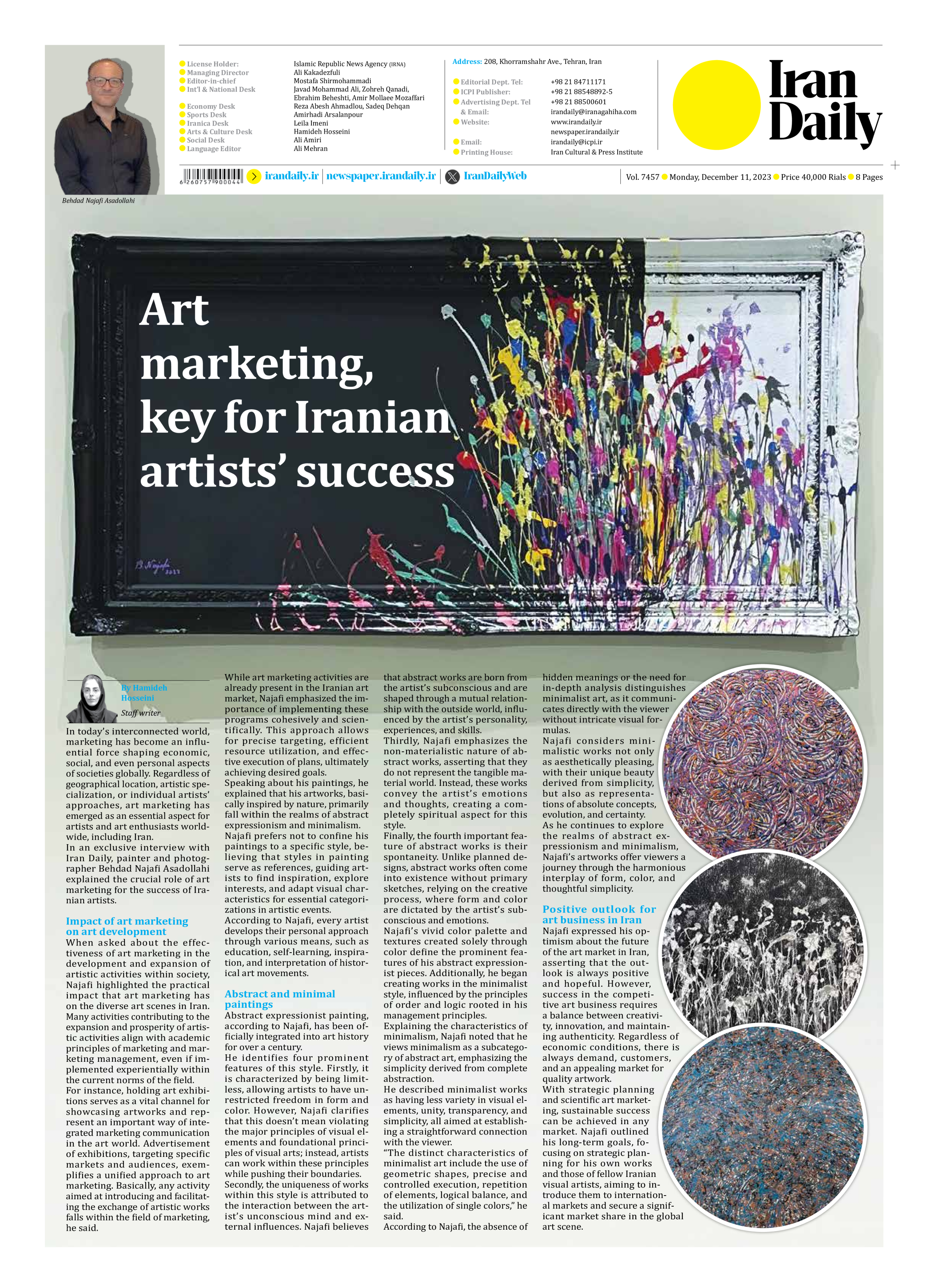
Art marketing, key for Iranian artists’ success
In today’s interconnected world, marketing has become an influential force shaping economic, social, and even personal aspects of societies globally. Regardless of geographical location, artistic specialization, or individual artists’ approaches, art marketing has emerged as an essential aspect for artists and art enthusiasts worldwide, including Iran.
In an exclusive interview with Iran Daily, painter and photographer Behdad Najafi Asadollahi explained the crucial role of art marketing for the success of Iranian artists.
Impact of art marketing
on art development
When asked about the effectiveness of art marketing in the development and expansion of artistic activities within society, Najafi highlighted the practical impact that art marketing has on the diverse art scenes in Iran. Many activities contributing to the expansion and prosperity of artistic activities align with academic principles of marketing and marketing management, even if implemented experientially within the current norms of the field.
For instance, holding art exhibitions serves as a vital channel for showcasing artworks and represent an important way of integrated marketing communication in the art world. Advertisement of exhibitions, targeting specific markets and audiences, exemplifies a unified approach to art marketing. Basically, any activity aimed at introducing and facilitating the exchange of artistic works falls within the field of marketing, he said.
While art marketing activities are already present in the Iranian art market, Najafi emphasized the importance of implementing these programs cohesively and scientifically. This approach allows for precise targeting, efficient resource utilization, and effective execution of plans, ultimately achieving desired goals.
Speaking about his paintings, he explained that his artworks, basically inspired by nature, primarily fall within the realms of abstract expressionism and minimalism.
Najafi prefers not to confine his paintings to a specific style, believing that styles in painting serve as references, guiding artists to find inspiration, explore interests, and adapt visual characteristics for essential categorizations in artistic events.
According to Najafi, every artist develops their personal approach through various means, such as education, self-learning, inspiration, and interpretation of historical art movements.
Abstract and minimal
paintings
Abstract expressionist painting, according to Najafi, has been officially integrated into art history for over a century.
He identifies four prominent features of this style. Firstly, it is characterized by being limitless, allowing artists to have unrestricted freedom in form and color. However, Najafi clarifies that this doesn’t mean violating the major principles of visual elements and foundational principles of visual arts; instead, artists can work within these principles while pushing their boundaries.
Secondly, the uniqueness of works within this style is attributed to the interaction between the artist’s unconscious mind and external influences. Najafi believes that abstract works are born from the artist’s subconscious and are shaped through a mutual relationship with the outside world, influenced by the artist’s personality, experiences, and skills.
Thirdly, Najafi emphasizes the non-materialistic nature of abstract works, asserting that they do not represent the tangible material world. Instead, these works convey the artist’s emotions and thoughts, creating a completely spiritual aspect for this
style.
Finally, the fourth important feature of abstract works is their spontaneity. Unlike planned designs, abstract works often come into existence without primary sketches, relying on the creative process, where form and color are dictated by the artist’s subconscious and emotions.
Najafi’s vivid color palette and textures created solely through color define the prominent features of his abstract expressionist pieces. Additionally, he began creating works in the minimalist style, influenced by the principles of order and logic rooted in his management principles.
Explaining the characteristics of minimalism, Najafi noted that he views minimalism as a subcategory of abstract art, emphasizing the simplicity derived from complete abstraction.
He described minimalist works as having less variety in visual elements, unity, transparency, and simplicity, all aimed at establishing a straightforward connection with the viewer.
“The distinct characteristics of minimalist art include the use of geometric shapes, precise and controlled execution, repetition of elements, logical balance, and the utilization of single colors,” he said.
According to Najafi, the absence of hidden meanings or the need for in-depth analysis distinguishes minimalist art, as it communicates directly with the viewer without intricate visual formulas.
Najafi considers minimalistic works not only as aesthetically pleasing, with their unique beauty derived from simplicity, but also as representations of absolute concepts, evolution, and certainty.
As he continues to explore the realms of abstract expressionism and minimalism, Najafi’s artworks offer viewers a journey through the harmonious interplay of form, color, and thoughtful simplicity.
Positive outlook for art business in Iran
Najafi expressed his optimism about the future of the art market in Iran, asserting that the outlook is always positive and hopeful. However, success in the competitive art business requires a balance between creativity, innovation, and maintaining authenticity. Regardless of economic conditions, there is always demand, customers, and an appealing market for quality artwork.
With strategic planning and scientific art marketing, sustainable success can be achieved in any market. Najafi outlined his long-term goals, focusing on strategic planning for his own works and those of fellow Iranian visual artists, aiming to introduce them to international markets and secure a significant market share in the global art scene.







